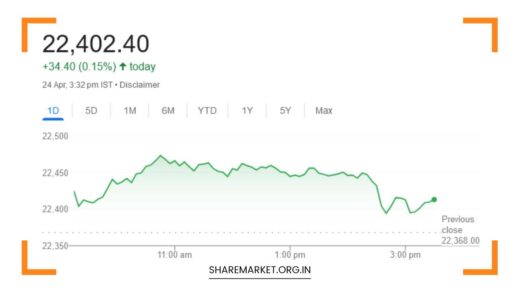Stock Market Crash: Why Did Stock Market Crash Today

Stock Market Crash Today
Navigating the Recent Market Turmoil: Causes, Implications, and Strategic Responses
The recent upheaval in the domestic market has sent shockwaves through investors as selling pressure escalated for two consecutive days, reaching what can only be described as a near-collapse.
The equity benchmark indices, Sensex and Nifty, witnessed a plunge of over 2 percent, with Sensex dipping below the critical 71,500 mark and Nifty slipping beneath 21,600 in intra-day trading.
This abrupt market fall, the most significant in the past 18 months, has triggered widespread panic among investors, prompting a quest for answers regarding the root causes of the selling pressure and, more importantly, the precautions they should undertake to safeguard their investments.
Understanding the Collapse:
The collapse of Sensex and Nifty can be attributed to a confluence of factors that have converged to create a perfect storm in the financial markets. One primary factor is the apparent overbought condition of the market at its current level.
All categories of investors, including Foreign Institutional Investors (FIIs), Mutual Funds, and Individual Investors, have been displaying a bullish trend.
While a unified bullish trend among investors is generally positive, it can also set the stage for unexpected and drastic market movements, as witnessed recently.
It is essential to note that despite the recent market turmoil, it is premature to conclusively state that the bullish trend has come to an end.
The heightened selling pressure, however, serves as a warning sign and necessitates a thorough evaluation of the prevailing market sentiment.
Global Economic Factors:
Global economic dynamics have played a pivotal role in shaping the recent market downturn. Initially, investors worldwide were optimistic about potential rate cuts by the US Federal Reserve.
However, conflicting signals from some members of the Fed, indicating no urgency for rate cuts, have dampened these expectations. This uncertainty has contributed to the prevailing unease in the financial markets.
Furthermore, weaker-than-expected GDP figures in China have added to the global economic concerns. The possibility of a decline in real estate prices in specific Chinese cities looms large, with potential repercussions on the overall economic performance.
The interconnectedness of the global economy means that events in one part of the world can have far-reaching consequences for financial markets worldwide.
Stock-specific Challenges:
Another contributing factor to the market collapse is the heavy selling observed in HDFC Bank, a heavyweight stock in the index.
Saurabh Jain, Research Equity Head at SMC Global Securities, highlights these external factors, along with stock-specific challenges, as key drivers of the intense pressure on the market.
Stock-wise Analysis:
Post a recent upward trend, shares began to appear overvalued, prompting investors to book profits. Looking ahead, the fate of mid and small-cap stocks is contingent on the results of the December quarter.
Stocks with financial health not meeting expectations may witness a sharp decline, making it crucial for investors to scrutinize their portfolios carefully.
Contrastingly, large-cap stocks have experienced less growth compared to their mid and small-cap counterparts.
However, they are considered more attractive for investment at the moment. According to brokers, some astute investors have already started increasing their investments in large-cap stocks over the last two months.
The abrupt fall in large-cap stocks can be attributed to investors attempting to compensate for losses in certain shares by booking profits in others.
Guidance for Retail Investors:
Amidst the market turmoil, retail investors are advised to take a pragmatic and informed approach. Despite the recent downturn, the fundamentals of the Indian economy remain robust.
The GDP is growing at a commendable pace, inflation is within manageable limits, corporate balance sheets are healthy, and earnings growth is robust across most sectors.
For those invested in mutual funds and systematic investment plans (SIPs), maintaining the status quo is recommended. However, for investors with individual stock holdings, this is an opportune moment for a thorough portfolio assessment.
The emphasis should be on reducing exposure to stocks with weak fundamentals and increasing investments in quality stocks, irrespective of their market capitalization – be it large, mid, or small-cap.
Saurabh Jain provides valuable insights, suggesting that if the fundamentals of a sector and a particular stock appear strong, the ongoing market decline could be viewed as an opportunity to strengthen one’s portfolio.
Instead of being swayed by short-term market fluctuations, investors are encouraged to consider a long-term perspective when dealing with fundamentally strong stocks and sectors.
The Long-Term Economic Landscape:
In the midst of the current market turmoil, it is crucial for investors to maintain a long-term perspective. While short-term fluctuations can be unnerving, a focus on the broader economic landscape is essential for making informed investment decisions.
The fundamentals of the Indian economy continue to be a source of strength. The GDP growth rate is commendable, inflation is well within limits, corporate balance sheets remain healthy, and earnings growth is evident across various sectors. These positive economic indicators provide a solid foundation for long-term investments.
Strategic Responses for Investors:
In times of market uncertainty, investors should consider adopting strategic responses to safeguard their portfolios and potentially capitalize on emerging opportunities. Several key considerations include:
- Diversification: Ensuring a well-diversified portfolio is a fundamental strategy to mitigate risks. By spreading investments across different asset classes, sectors, and geographic regions, investors can reduce the impact of adverse market movements on their overall portfolio.
- Quality Over Quantity: Emphasizing the quality of investments over sheer quantity is crucial. This involves conducting thorough research on individual stocks, assessing their fundamentals, and focusing on companies with strong financial health and growth prospects.
- Assessment and Rebalancing: Conducting a comprehensive assessment of the existing portfolio is imperative. Identifying underperforming or high-risk assets and rebalancing the portfolio accordingly can help align investments with the investor’s risk tolerance and financial goals.
- Opportunistic Buying: Market downturns often present opportunities for value investing. Savvy investors with a long-term outlook may consider selectively increasing their exposure to fundamentally sound stocks that have experienced price declines.
- Staying Informed: Keeping abreast of economic indicators, global developments, and company-specific news is essential. Informed decision-making requires a thorough understanding of the broader economic landscape and its potential impact on individual investments.
- Reviewing Financial Goals: Periods of market volatility provide an excellent opportunity for investors to revisit and reassess their financial goals. This involves evaluating short-term and long-term objectives, risk tolerance, and investment horizon to ensure that the current portfolio aligns with these goals.
- Professional Advice: Seeking guidance from financial advisors can be invaluable during turbulent market conditions. Financial professionals can provide personalized advice based on an individual’s financial situation, goals, and risk tolerance.
Final Remarks:
In conclusion, the recent market turmoil necessitates a comprehensive understanding of the factors contributing to the upheaval, as well as strategic responses for investors to navigate through these challenging times.
The combination of global economic uncertainties, overbought market conditions, and specific stock-related challenges has created a complex environment.
Retail investors are encouraged to approach the situation with a level-headed perspective, capitalizing on this period to reassess and fortify their portfolios.
Despite the short-term market fluctuations, the fundamentals of the Indian economy remain robust, providing a solid foundation for long-term investments.
By adopting strategic responses, such as diversification, quality-focused investing, portfolio rebalancing, and staying informed, investors can navigate the current market turbulence with resilience.
Ultimately, maintaining a long-term perspective and aligning investments with individual financial goals will contribute to sustained success in the ever-evolving financial landscape.

















